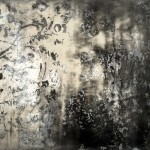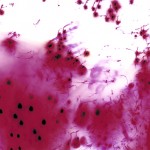Interview with Natalie Cheung by Jessica Naresh
Jessica Naresh: What drew you to utilizing photographic processes in unconventional ways?
Natalie Cheung: I was trained as a traditional photographer and for a long time I was very interested in setting up still life with a formalist minimalist look. Later realizing that I was more interested in the objects I was photographing, mostly from nature, I starting using a 4×5 field camera creating very textural landscape-esque images. One thing I became continually frustrated with was the control I had over the compositions. I was interested in capturing these patterns in nature, seemingly unique and created by chance happenings, but was not creating or showing anything that didn’t already exist with these photographs.
I started making photograms, which is simply placing an object on photosensitive paper and exposing (which creates an x-ray like image), because it was a way I was able to document an object and its texture without being able to completely replicate the moment of exposure. As there is no negative involved in the process, each print is unique
JN: Some of the processes you have used to create different bodies of work have been cyanotypes, mordançage, and pinhole cameras. What is it that interests you in a particular photographic process?
NC: Generally what draws me to these photographic processes is their historical significance to the medium. Aside from mordançage, all the other photographic processes I use are some of the oldest and most basic techniques in photography. I really enjoy the purity that these processes bring to my work.
JN: Are there any processes that you want to work with that you haven’t yet?
NC: I don’t really seek out new processes to apply them to my work. Generally I have always just stumbled upon some anomaly in what I’m doing with a process and then conduct more experiments to try to somehow re-create the anomaly, with equal parts of success and failure.
JN: What role do chance happenings play in your work?
NC: Chance keeps me interested in making work. Not only do the processes I use rely heavily on chance happenings but one of the main purposes of the work is having a photographic medium to physically capture a moment of chance on paper.
JN: In addition to chance happenings, what other concepts are you exploring through your work?
NC: A core concept that I explore in my work is using the photographic medium not as a tool to capture visual memory, but to attempt to capture the physical presence of a fleeting experience.In my “Intermediaries” series, mappings of evaporation are created from an event that has physically taken place on the paper. In “Movements,” the light-saturated silver gelatin paper effectively has the light and layers of gelatin clawed, rubbed and torn away, in some cases revealing and leaving just the bare white base of the photographic paper.
JN: Do you have a favorite artist?
NC: I don’t have one particular favorite artist, but a few of my favorites are Francesca Woodman, Michiko Kon, Cy Twombly and Sol Lewitt.
Tags: Journal

